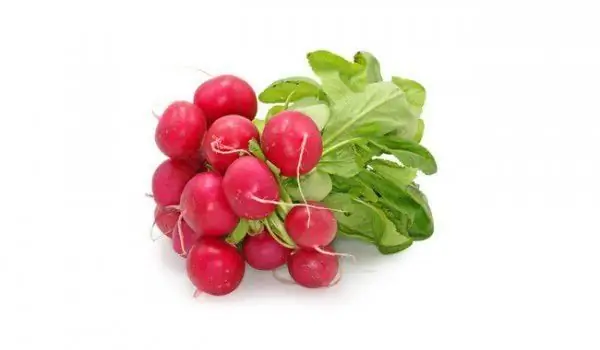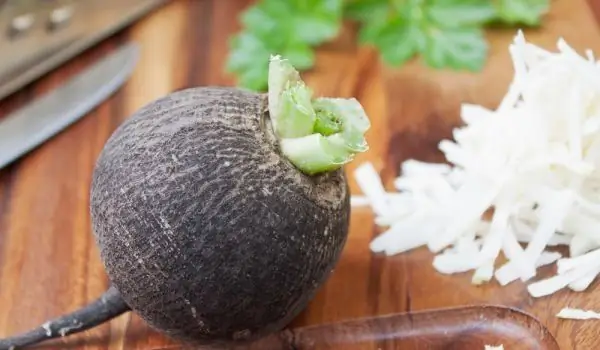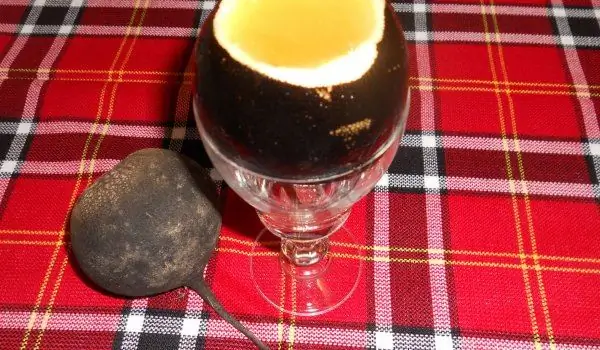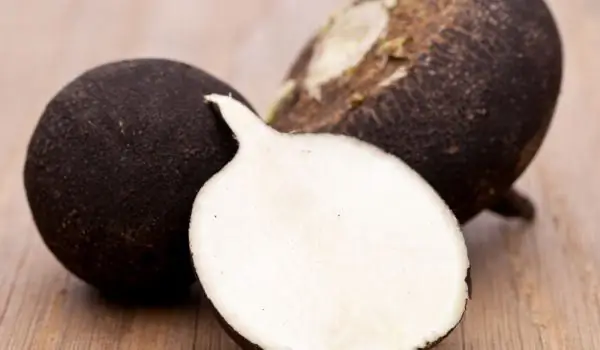2025 Author: Jasmine Walkman | [email protected]. Last modified: 2025-01-23 10:18
Black radish / Raphanus sativus niger / is a biennial root plant, which in the first year forms a leaf rosette and root crop, and in the second forms a flowering stem. Black radish is widespread in many places in Europe and Asia (especially in Korea, China and Japan). Along with white radish, it is a characteristic agricultural crop for our latitudes.
Black radish is distinguished by its large spherical root, which is quite dark, almost black, reaching 5 to 20 centimeters. Its inner part is whitish to yellowish, with a strong pungent taste and a specific odor. The flowering stem of black radish reaches 1 meter in height. Black radish blooms with white flowers, but in some varieties of the variety may be present and other colors.
Composition of black radish
This culture has a rich chemical composition. It is a source of vitamin A, vitamin B2, vitamin C, vitamin P and vitamin K. In its composition root vegetables have potassium, calcium, magnesium, phosphorus and others. This type of turnip is a source of glucosides, pectin and others.
Growing black radish
Black radish belongs to the cold-resistant species. In general, it easily tolerates cold, but if the weather is seriously cold, it can shoot before it has formed a root crop. That is why agronomists point out the temperature of 16-17 degrees as the most favorable for the development of this crop.
Otherwise, black radish is a light-loving plant, so when sowing it, it is preferable to avoid too shady areas in your garden. This type of turnip is relatively demanding and to the soil - preferably loose and nutrient-rich soils. The richer they are, the greater the chance that the harvest will be satisfactory. In poor soils, the root crop is likely to remain small.
When growing black radish, it is recommended to fertilize the plant. If you have animal manure, you can safely use it. Keep in mind that droughts do not have a positive effect on black radish, so during the growing season, which takes about 3 months, regular watering is recommended.
Agronomists note that the best results are observed with drip irrigation. Black radish is often used as a second crop. The seeds are buried regularly in late summer. As soon as 2 true leaves appear, the plants are thinned. The roots can be removed in early November.
Selection and storage of black radish
If you have grown your own turnip, you will be able to harvest it shortly before winter comes. The harvested crop should be stored in a cool and dark place. It is recommended to place the root in moist sand to keep it edible for at least 2 months. If you wish, you can also store the turnips in the refrigerator. For this purpose, you can wrap it in plastic wrap and place it in a separate compartment. In the refrigerator it will keep its freshness for about a month.
If we do not have the right conditions to grow black radish at home, we can buy one from the market. Fortunately, there is already a great variety of this product in retail chains. When choosing turnips, you should know that you should not aim for large specimens, as there is a danger that they will become bitter. Inspect turnips that are medium in size and have no external injuries. When touched, fresh turnips should be firm and not emit an unpleasant odor.

Cooking black radish
Black radish used in the cooking of Asian peoples, and also in our cuisine. Although it can be subjected to heat treatment, it is accepted that it is best consumed fresh. However, we can not fail to note that it is used in soups and stews. Peel a squash, grate it and cut it into small pieces. It can also be grated.
Saturated raw radish is a component of favorite salads, where it is combined with beets, cabbage, carrots, celery, peppers, potatoes, tomatoes, corn, olives, parsley, dill, garlic. Although less common, some chefs add to salads with turnips and boiled eggs. Salads with turnips are seasoned with vinegar or lemon juice. Mayonnaise and yoghurt also give them a pleasant finish.
In addition to salads, turnips can be included in pickles along with cauliflower, gherkins, green tomatoes, carrots and cambi.
Benefits of black radish
The beneficial properties of black radish have been known to humans since time immemorial. This root plant is used as an appetite stimulant and cholagogue and for kidney stones. Studies show that black radish improves the digestive system, strengthens the immune system and has anti-influenza effects.
The crushed seeds of this type of turnip are used as an antimicrobial agent. Turnip juice is drunk for a sore throat. In addition, black radish cleanses the liver and protects it from the dangerous effects of harmful substances.
Another positive property of black radish is that it can normalize high blood pressure. The researchers came to this conclusion after conducting a study with 120 people suffering from hypertension. Experience has shown that after consuming black radish, their blood pressure levels dropped significantly.
Folk medicine with black radish
Folk medicine recommends black radish especially with persistent cough and lung problems. For this purpose, the root is cut and carved. Put sugar in it and wait until a syrup is formed. Take a few teaspoons of the liquid a day until the unpleasant symptoms disappear.
Recommended:
Delicious And Healthy Salads With Black Radish

Radishes, as well as white radish are relatively common in our menu. But why do we avoid consuming black radish, when it is so useful for our body? IN black radish contains a substance known as lysozyme and known to have potent antimicrobial activity.
Do Not Throw Away The Radish Leaves! They Are The Most Useful

Believe it or not, the leaves actually contain more nutrients than the radish itself. They are packed with properties that help keep diseases away from you. The green parts of the radish contain more nutrients than the radish itself. They help provide a diet rich in nutrients, as well as some important minerals such as iron, calcium, folic acid, vitamin C and phosphorus, which are essential for many bodily functions.
Delicious Dishes With Black Radish

Turnips is one of the vegetables that is used both in cooking and for the famous grandmother's remedies. Black radish contains Vitamin B and C, and has many other useful properties. It is widespread in many countries, not only in Bulgaria. Black radish juice is useful for relieving cough.
This Grandmother's Recipe With Black Radish Cures Cough And Sore Throat

During the winter months, when our immunity is low and we are attacked by viruses from everywhere, coughs, sore throats, stuffy noses and high temperatures are our constant companions. There are many ways to deal with these unpleasant symptoms, but sometimes the drugs we know don't work.
Why Is It So Important To Eat Black Radish?

Fans of black radish unfortunately they are very few. However, in case it seems too spicy or with a sharper taste, you can always add a little salt after peeling. In just a few minutes, her sharp taste will change. And about why it is so important to eat black radish, read in the following lines.

